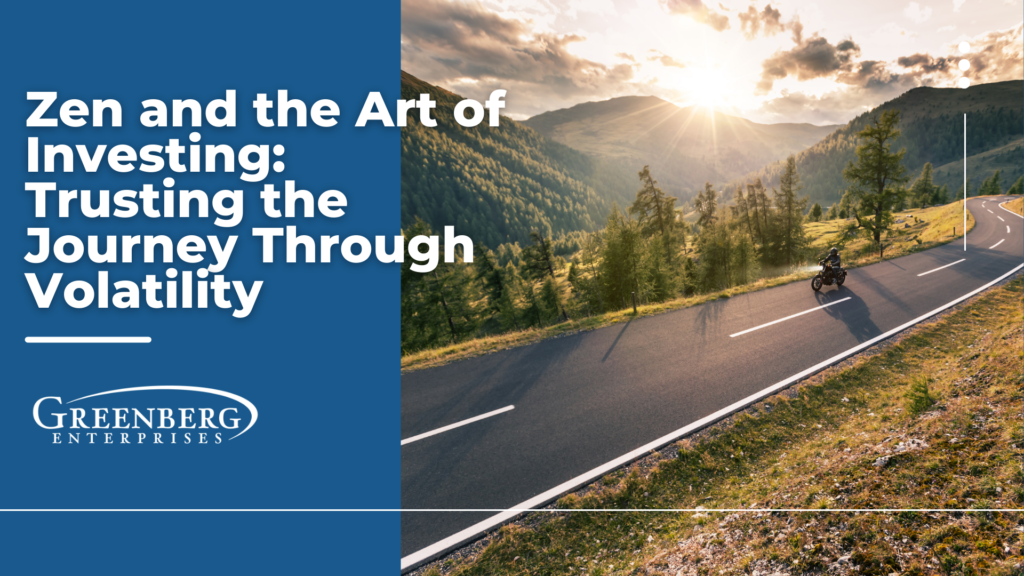
Zen and the Art of Investing: Trusting the Journey Through Volatility
Not financial advice. Please do your own research. We are simply sharing our learnings along the way. Trade your trade!
For those of you who don’t know me, I read everything with the word motorcycle in it. One book set a tone for me. Zen and the Art of Motorcycle Maintenance, by Robert Pirsig describes a rider’s bond with his machine and the road: “The real cycle you’re working on is a cycle called yourself.” Investing, particularly in small-cap stocks, mirrors this journey. The market’s volatility is the winding road; the companies we invest in are the machines we’ve chosen. When the terrain gets rough, do we hold steady or abandon the ride? History, data, and a touch of Zen wisdom suggest that trusting the journey, often leads to the most rewarding destinations.
The Road’s History: Lessons from the Russell 2000
A motorcycle rider doesn’t judge a bike by how it handles a single pothole but by how it endures the full trip. The Russell 2000 Index, a benchmark for small-cap stocks, has proven its mettle through some of the market’s toughest stretches. Consider two pivotal moments:
- 2008 Financial Crisis: From its 2007 peak of 856 points, the index crashed 60.5% to 337 points by March 2009 [Macrotrends.net]. Yet, by April 2011, it roared back to 857 points—a 154.3% gain from the low. Selling at the bottom locked in losses; holding or buying into the chaos fueled a remarkable recovery.
- 2020 Pandemic: The index fell 41.8% from 1,672 points in February to 973 points by March 23, 2020 [Macrotrends.net]. By February 2021, it climbed to 2,245 points—a 130.7% surge. Those who stayed aboard captured explosive gains; those who bailed missed the ride.
These rebounds weren’t luck. They stemmed from small companies with strong engines (adaptable leadership and solid fundamentals) that powered through. For investors, it’s a lesson in faith: a well-built machine can handle the bumps.
The Risks of Jumping Off: Timing, Costs, and Noise
Pirsig’s rider doesn’t ditch his bike at the first sputter; he pulls over, tinkers, and trusts the process. Selling during market dips is like leaping off mid-journey; you might dodge a jolt, but you’ll miss the destination ahead.
- Timing Is a Mirage: Studies consistently show that missing the market’s best days, often clustered after the worst, guts returns. In 2009 and 2020, the Russell 2000’s sharpest climbs followed its steepest falls.
- Costs Wear You Down: Trading racks up fees and taxes, eroding gains like friction on a worn tire. Holding lets compounding do the heavy lifting.
- Noise Fuels Panic: A 2022 study by Cookson, Fos, and Niessner found that retail traders, swayed by social media chatter, often buy high and sell low during volatility [Cookson et al., 2022]. In 2020, cashing out in March avoided a fleeting dip, but cash earned near-zero while small caps soared 130.7% by early 2021.
Selling early trades conviction for comfort, often at a steep price.
Opportunity Cost: Knowing When to Recalibrate
Every rider weighs their route. Sometimes a detour makes sense if the path ahead crumbles. Opportunity cost, the lure of a smoother road, matters in investing too. But small caps have a strong case for staying put:
- Historical Outperformance: Post-2008, the Russell 2000’s 154.3% rebound outstripped bonds, cash, and even large caps. The same pattern held in 2020.
- The Trap of Reaction: The Cookson study shows that short-term trading, especially amid volatility, often lags a steady hold. Emotional moves turn dips into losses.
Still, if a company’s engine falters—leadership stalls, the vision fades, or the model breaks—reallocating can be wise. For well-chosen small caps, though, the data tilts toward endurance over escape.
The Zen of Investing: Patience as the Path
Pirsig writes, “Peace comes not from avoiding the road’s trials, but from embracing them with clarity and care”. Investing demands the same. Volatility isn’t a threat, by holding through it, rooted in research and belief, we let our machines prove their worth.
The Russell 2000’s triumphs—154.3% after 2008, 130.7% after 2020—rewarded those who stayed calm. Some small caps stall, sure, but careful selection and diversification temper that risk. Chasing trends or fleeing at every wobble, as the 2022 study warns, often strands us in the dust. As Pirsig might put it, the true work is within: mastering patience, trusting the craftsmanship, and riding out the bumps with purpose.
Sources
- Russell 2000 Historical Data: Macrotrends.net – Russell 2000 Index
- Cookson, J. A., Fos, V., & Niessner, M. (2022): Retail Trading and Asset Prices: The Role of Changing Social Dynamics
